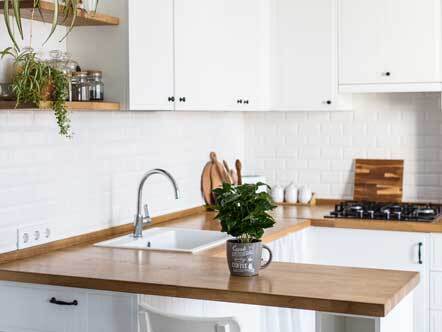Small amounts of damp and condensation will appear in nearly every home. If left unchecked mould can easily start to form, turning the damp from a common problem to a health hazard.
We've developed this guide to help you identify and reduce damp and condesation, as well as treating the mould growth that often comes alongside it.
Types of damp
There are four tyes of damp that could affect your home. It is important to understand the difference between them so you can effectively treat the problem.
Rising damp
This is caused by water rising from the ground into the home. The water gets round or through a broken Damp Proof Course (DPC) or passes through the natural brickwork if the property was built without a DPC. A DPC is a horizontal layer of waterproof material put in the walls of a building just above ground level. It stops moisture rising through the walls by capillary action.
Rising damp will only affect basements and ground floor rooms. It will normally rise no more than 12 to 24 inches above ground level and usually leave a 'tide mark' low down on the wall. You may also notice white salts on the affected area.
Rising damp will be present all year round, but is more noticable in winter. If left untreated it may cause wall plaster to crumble and paper to lift in the affected areas.
Penetrating damp
This type of damp will only be found on external walls or, in the case of roof leaks, on ceilings. It only appears because of a defect outside the home, such as missing pointing to the brickwork, cracked rendering or missing roof tiles. These defects then allow water to pass from the outside to the inner surfaces.
Penetrating damp is far more noticable following a period of rainfall and will normally appear as a well defined 'damp patch' which looks and feels damp to the touch.
Defective plumbing
Leaks from water and waste pipes, especially in bathrooms and kitchens, are relatively common. They can affect both external and internal walls and ceilings. The affected area looks and feels damp to the touch and remains damp regardless of the weather conditions outside.
Have a quick examination of the water and waste pipes in the kitchen and bathroom, as well as the seals around the bath, shower and sinks. Also remember to look at the external pipework, such as guttering. This will usually reveal the source of the leak.
Condensation
The most common cause of dampness experienced by tenants and householders. Condensation is caused when air containing water vapour is cooled by contact with a cold surface. These damp areas then attract black mould that grows on the surface. Condensation mainly occurs in the colder months whether it is rainy or dry outside. It is usually found in the corners of rooms and near or on windows.
Steps to reduce condensation and black mould growth
Condensation and mould growth are to a certain extent inevitable in most houses, especially in older properties. However, there are steps you can take to reduce condesation and stop the spread of mould before it becomes dangerous.
Produce less moisture
Ordinary daily activities produce a lot of moisture. To reduce this:
- Dry clothes outdoors. Avoid drying clothes indoors or if you have to, dry them on a clothes airer in the bathroom with the door closed and either an extractor fan on or a window slightly open.
- Vent tumble driers to the outside (never into the home) or buy a condensing type.
- Cover pans when cooking and do not leave kettles boiling.
- Do not use paraffin or liquid petroleum (bottled) gas heaters. They produce large amounts of water vapour and are very expensive to run.
Remove excess moisture
Always wipe the windows and windowsills of your home every morning to remove condensation. This is especially important in the debroom, bathroom annd kitchen. If you can, think about investing some mini dehumidifiers to place in damp corners and by windows.
Ventilate to remove moisture
It is important to remove condensation and excess moisture by ventilating rooms. You can ventilate a room without making draughts or causing it to become cold. To do this you may only need to open the window slightly or use the trickle vent that can often be found on new UPVC windows. This allows warm (but moist) air to escape to the outside and let in cool (but dry) air.
In cold weather, the best way to keep rooms warm and avoid condensation is to keep low background heat on all day rather than short bursts of high heat when you are in the house.
Insulate and draught proof
This will help keep your home warm and save money on your heating bills.
Dealing with black mould
Black mould can grow on walls, ceilings, furnishings and even on clothes and toys. To kill and remove the mould:
- Carefully remove excess mould with a damp cloth and throw away after. Or if possible use a vacuum cleaner and empty after. Do not brush mould as this releases spores into the air.
- Wipe down affected areas using a fungicidal wash or diluted bleach – remember to always use rubber gloves and wear safety glasses.
- Tea Tree oil is a natural antiseptic and disinfectant but it is also great for cleaning especially on mould or mildew. Try a dilute of three to four drops of Tea Tree oil in two litres of water (hot or cold). Soak mildewed items in the solution or spray on to trouble spots using a plant mister. Wipe, then rinse off. Always ensure you carry out a test on a small area of the fabric/material/surface beforehand.
- After treatment redecorate using a fungicidal paint or wall paper paste - do not paint over using an ordinary paint.
- Dry clean mildewed clothes and shampoo carpets.
Additional support with cost of living challenges
If you are struggling with energy costs you can find advice and support at:ofgem.gov.uk/information-consumers/energy-advice-households
There is a Priority Services Register to provide extra help to those in vulnerable situations: ofgem.gov.uk/get-help-your-supplier-priorityservices- register
Information about Cost of Living Payments can be found at: gov.uk/guidance/cost-of-living-payment
Grants of between £5,000 and £25,000 are available to eligible lowincome homeowners and private tenants as part of the Warmer Homes
programme: warmerhomes.org.uk/eligibility



